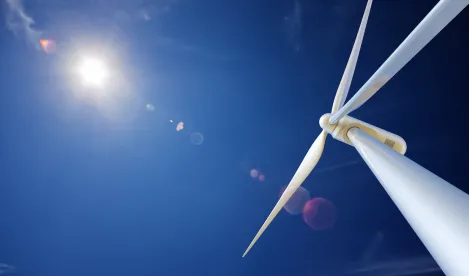Offshore wind development in federal waters off the California coast is rapidly moving closer to reality. Although construction and operation remains several years away, the Bureau of Ocean Energy Management (BOEM), the federal agency within the U.S. Department of the Interior tasked with regulating off-shore energy development, has taken several major steps over the past year toward opening up California’s federal waters to renewable energy development. And, on the horizon for fall 2022, the agency plans to hold its first lease auction during which renewable energy developers will have an opportunity to bid for the right to develop the state’s first offshore wind farms.
TWO CALIFORNIA AREAS DESIGNATED FOR OFFSHORE WIND DEVELOPMENT
BOEM has designated two areas off California’s northern and central coasts for offshore wind development. The first area designated by the agency was the Humboldt Wind Energy Area in northern California about 21 miles offshore of Eureka. Designated in 2018, this approximately 206 square mile area has the potential, if fully developed, to generate up to 1.6 gigawatts (GW), enough to power approximately 560,000 homes. In January 2022, BOEM took one step closer to opening the area up to development and released a draft Environmental Assessment (EA), required by the National Environmental Policy Act (NEPA), evaluating the potential environmental impacts of granting leases in the Humboldt Wind Energy Area. Once the comment period is complete, a final EA is released, and a decision then is made by BOEM to proceed, and unless there is a legal challenge, the agency can then begin auctioning off leases in the area, the first of several final steps necessary before construction and generation can begin.
In November 2021, BOEM announced a second area, the Morro Bay Wind Energy Area. The Morro Bay Wind Energy Area comprises approximately 376 square miles off California’s central coast and, due to its larger size, has the potential to generate 2.9 GW, or enough energy to supply more than 1,000,000 homes. While an EA has not yet been prepared, BOEM is currently engaged in a public scoping process and a draft EA is set for release later this spring.
Following BOEM’s review of environmental impacts associated with leasing and site characterization activities, and assuming no legal challenges, the Humboldt and Morro Bay Wind Energy Areas will move into the lease issuance phase. BOEM plans to hold a joint auction for both Wind Energy Areas, currently scheduled for fall 2022, and companies interested in developing offshore wind energy will bid for the right to develop in these areas. After the auction, lessees will survey and study their lease areas and once this site assessment phase is complete, development can move forward into the construction and operations phases.
DEVELOPMENT MAY FACE CHALLENGES
However, before approving the construction of any offshore wind energy facility, further environmental review will be required under NEPA. BOEM will develop a facility-specific Environmental Impact Statement to analyze the specific environmental consequences of constructing and operating facilities in the Humboldt and Morro Bay Wind Energy Areas. Developers will also submit, for agency approval, a detailed site assessment, construction plan, and operations plan for their proposed projects. Only once the agency approves these plans can construction begin, assuming no legal challenge to the particular project.
Development will not be without significant obstacles. In addition to the technical and logistical hurdles associated with the design and installation of offshore facilities, developers, investors, and contractors will need to navigate a host of regulatory challenges. For example, the Marine Mammal Protection Act may, and the Coastal Zone Management Act will, apply to these projects. Furthermore, as electrical cables transmitting the generated power to shore must pass through state waters to get to land-based power substations, and upgrades to grid infrastructure and other land-based facilities may be required, project developers will need to obtain a range of other federal, state, and local permits to accompany their BOEM lease. For example, in addition to environmental review under NEPA, future projects will likely result in a range of environmental impacts in state waters and on private or public land, thus triggering compliance with the California Environmental Quality Act, the California Coastal Act, and other regulatory programs, as well as State Lands Commission jurisdiction, the land use authority of local governments, and potentially other environmental protection laws such as the federal and state Endangered Species Acts.
LEASE SALES IS A MAJOR STEP IN RENEWABLE ENERGY DEVELOPMENT
Although it will be several years before the first offshore wind energy can start flowing into California’s power grid, BOEM’s upcoming fall 2022 lease sale represents a major step towards tapping into what a recent National Renewable Energy Laboratory report estimates to be more than 200 GW of potential capacity off the California coast. And, as a single GW can support up to 350,000 homes, it is already clear that offshore development promises to become an important future contributor to California’s energy portfolio.





 />i
/>i

